mc²96 - Strip Assignment
The STRIP ASSIGNMENT buttons (in the centre section) allow you to assign the channel in access to a fader strip. They can also be used to assign a range of fader strips in one operation, or perform operations such as insert, move, swap and relocate.

For convenience, the same options can be found on the Central GUI side panel (in the Access/Assign 1 & 2 pages).
|
|
Please note: The STRIP ASSIGNMENT options can be locked (to protect the desk layout) by pressing the Lock ASN button located on the Extra Buttons display. Therefore, if you cannot assign a channel to a fader strip, check the status of this option.
Assigning a Single Fader Strip
The STRIP ASSIGN button allows you to assign the channel in access to a fader strip.
- Select a channel - either by pressing its fader SEL button or using the Access/Assign panel.
- Press the STRIP ASSIGN button (under STRIP ASSIGNMENT). The fader SEL buttons across the console flash, in green.
- Press a fader SEL to complete the assignment.
- You can press another fader SEL, to assign the same channel to another strip. For example, to duplicate the channel on a different BANK or LAYER.
- Deselect the STRIP ASSIGN button or press ESC (on the SCREEN CONTROL panel) to exit the strip assign mode.
Assigning Consecutive Fader Strips
The FIRST LAST button provides a quick way of assigning a range of channels to consecutive fader strips.
- Put the first channel you wish to assign into access - e.g. INP 1.
- Then press FIRST LAST (instead of STRIP ASSIGN). The fader SEL buttons across the console flash, in green.
- Press the fader SEL buttons on the first and last fader strips in the range (e.g. strip 1 and then strip 16).
- The console assigns the channels incrementally and then cancels the FIRST LAST mode.
- If all channels are mono, then INP 1 to 16 are assigned to fader strips 1 to 16.
- If some channels are stereo, then this is taken care of automatically. For example, if INP 1/2 and INP 3/4 are stereo, then they are assigned to fader strips 1 and 2; INP 5 is assigned to fader strip 3, INP 6 to fader strip 4, and so on.
- If some channels are surround, then it is the component channels which are assigned (e.g. L/R to fader strip 1, C to fader strip 2, etc). In this instance, it may be better to clear these strips and assign the Surround VCA master instead.
- Deselect the STRIP ASSIGN button or press ESC to exit the strip assign mode.
Please note:
- The start and end of the FIRST LAST range can be at any position across the control surface. Sources can be routed from left to right or from right to left by reversing the order of your first and last fader selection.
- FIRST LAST treats channel and main fader strips independently. This allows you to make changes to channel fader strips without affecting the main faders, or vice versa.
Clearing a Fader Strip
The CLEAR STRIP button can be used to remove a channel so that it leaves a blank fader strip.
- Press CLEAR STRIP (under MULTIPLE MODE). The fader SEL buttons across the console flash, in green.
- Press the fader SEL button(s) on any fader strips you wish to clear.
- When you are finished, deselect CLEAR STRIP or press ESC to exit the strip assign mode.
Inserting a Channel
The INSERT MOVE button can be used to insert a channel between two existing fader strips.
- Select the channel you wish to insert - either by pressing its fader SEL button or using the Access/Assign panel.
- Press INSERT MOVE (under STRIP ASSIGNMENT). The fader SEL buttons across the console flash, in green.
- Press the fader SEL button where you wish to insert the new channel - for example, on fader strip 5.
- The replaced channel, and all channels to its right, move one step to the right across the control surface.
- If a channel is assigned to the last fader strip on the right, then this drops off the end of the console and becomes a virtual fader.
For example, on a 32-fader control surface, the above operation would shift fader strip 32 up onto a virtual fader strip 33. This fader cannot be accessed, but remains in this location and is added back to the control surface if a channel is removed.
Please note:
- INSERT MOVE treats channel and main fader strips independently. This allows you to make changes to channel fader strips without affecting the main faders, or vice versa.
Removing a Channel
The INSERT MOVE button can also be used to remove a channel from a fader strip and automatically close the gap.
- Select the channel you wish to remove by pressing its fader SEL button.
- Press INSERT MOVE (under STRIP ASSIGNMENT). The fader SEL buttons across the console flash, in green, except for the channel in access which lights in red.
- Press the red fader SEL button to confirm the remove - all channels to the right ripple down the control surface to fill in the gap.
- If any virtual channels have been created, as the result of an insert operation, then these are added back to the surface.
Please note:
- INSERT MOVE treats channel and main fader strips independently. This allows you to make changes to channel fader strips without affecting the main faders, or vice versa.
Swapping Channels
The SWAP button can be used to swap two individual fader strips, or two different groups of consecutive fader strips.
To swap individual fader strips:
- Press the fader SEL button on the "source" fader (e.g. on strip 5).
- Press SWAP (under STRIP ASSIGNMENT). The fader SEL buttons across the console flash, in green
- Press the fader SEL button on the "destination" fader (e.g. on strip 8).
- The channel assignments are exchanged - in our example, the channel assigned to strip 5 moves to strip 8, and vice versa.
To swap two groups of consecutive fader strips:
- First, create a Couple group as follows:
- Press and hold the fader SEL buttons on the "source" faders.
- The fader SELs turn red to indicate that coupling is active (e.g. couple fader strips 3 to 6).
- Press SWAP (under STRIP ASSIGNMENT).
- Now press the fader SEL button on the first "destination" fader (e.g. on strip 9).
- The channel assignments are exchanged - in our example, the channels assigned to strips 3 to 6 move to strips 9 to 12, and vice versa.
You can use this method to exchange any number of fader strips as long as you observe the usual Couple group conditions.
Relocating Channels
The RELOCATE button can be used to relocate an individual fader strip, or a group of consecutive fader strips. In both cases, the "source" fader strips are cleared (left unassigned).
To relocate an individual fader strip:
- Press the fader SEL button on the "source" fader (e.g. on strip 5).
- Press RELOCATE (under STRIP ASSIGNMENT). The fader SEL buttons across the console flash, in green.
- Press the fader SEL button on the "destination" fader (e.g. on strip 8).
- The channel assigned to strip 5 moves to strip 8, and strip 5 is cleared (unassigned).
To relocate a group of consecutive fader strips:
- First, create a Couple group as follows:
- Press and hold the fader SEL buttons on the "source" faders.
- The fader SELs turn red to indicate that coupling is active (e.g. couple fader strips 3 to 6).
- Press RELOCATE (under STRIP ASSIGNMENT).
- Now press the fader SEL button on the first "destination" fader (e.g. on strip 9).
- The channels assigned to strips 3 to 6 move to strips 9 to 12, and strips 3 to 6 are cleared (unassigned).
You can use this method to relocate any number of fader strips as long as you observe the usual Couple group conditions.
Bank and Layer Strip Assignments
The MULTIPLE MODE buttons (under STRIP ASSIGNMENT) can be used to assign a channel to more than one bank (and layer) or copy/clear banks. These functions are particularly useful when first laying out the surface.
In each case, you will need to use both the MULTIPLE MODE and BANK buttons.

Assigning Channels to All Banks/Both Layers
The ALL BANK and BOTH LAYERS buttons can be used to assign a channel to several banks at a time, with the option to include both layers.
For example, to assign input channel 1 to fader strip 1 across both layers of all six control surface banks:
- Select INP 1 - either by pressing its fader SEL button or using the Access/Assign panel.
- Select ALL BANK and BOTH LAYERS (under MULTIPLE MODE).
- The fader SEL buttons across the console flash, in green, and the six BANK buttons 1 to 6 are lit.
- Deselect any BANK numbers which you do NOT want to include in the assignment (you cannot deselect the current bank). For our example, keep all six BANK buttons lit.
- Deselect BOTH LAYERS if you do NOT want to include both layers in the assignment. For our example, keep the button lit.
- Then press a flashing green fader SEL to complete the assignment (e.g. on fader strip 1).
Clearing a Bank of Fader Strips
The CLEAR BANK button can be used to clear a complete bank of fader strip assignments (including both layers).
- Press CLEAR BANK (under MULTIPLE MODE).
- Select the bank or banks you wish to clear using the BANK 1 to 6 buttons.
- Press ENTER (on the SCREEN CONTROL panel) to complete the operation.
Copying Banks
The COPY BANK button can be used to copy the current bank's fader strip assignments to a different bank or banks.
- Select the bank you wish to copy using the BANK 1 to 6 buttons - the control surface updates accordingly.
- Press COPY BANK (under MULTIPLE MODE).
- Select the bank numbers to copy to, using the BANK 1 to 6 buttons.
- Press ENTER (on the SCREEN CONTROL panel) to complete the operation.

